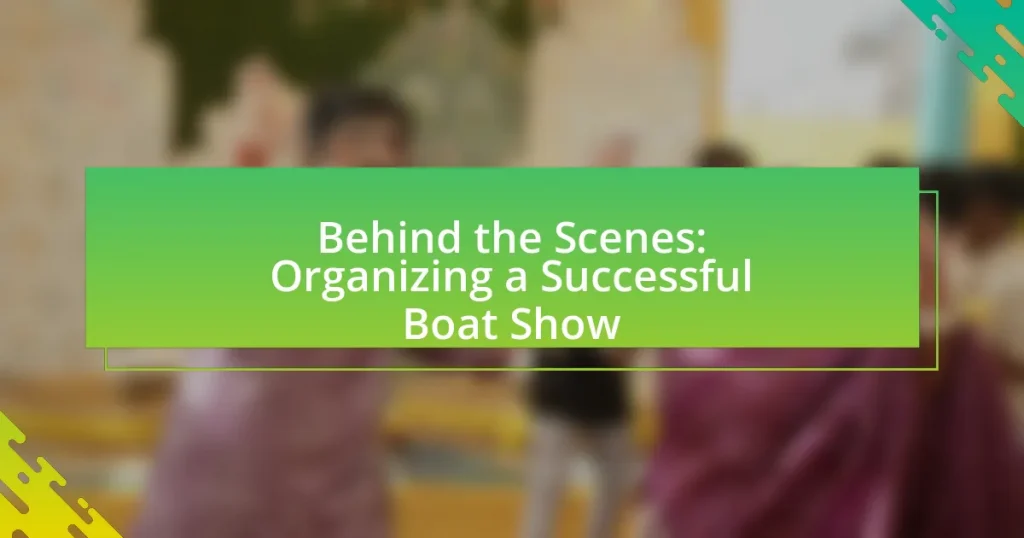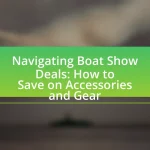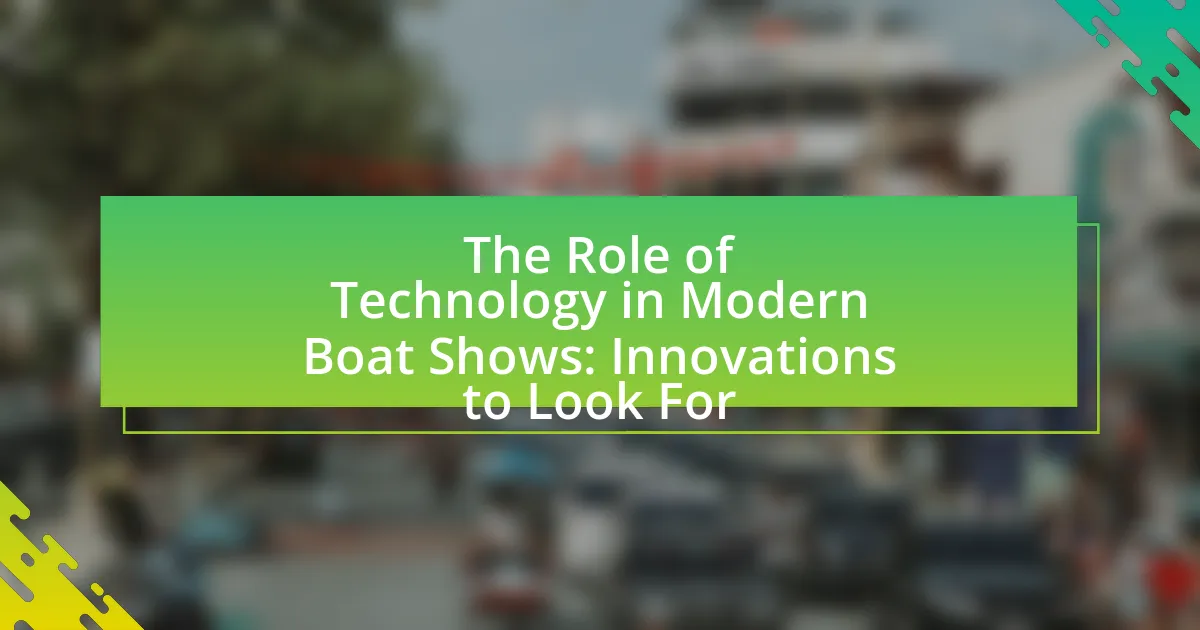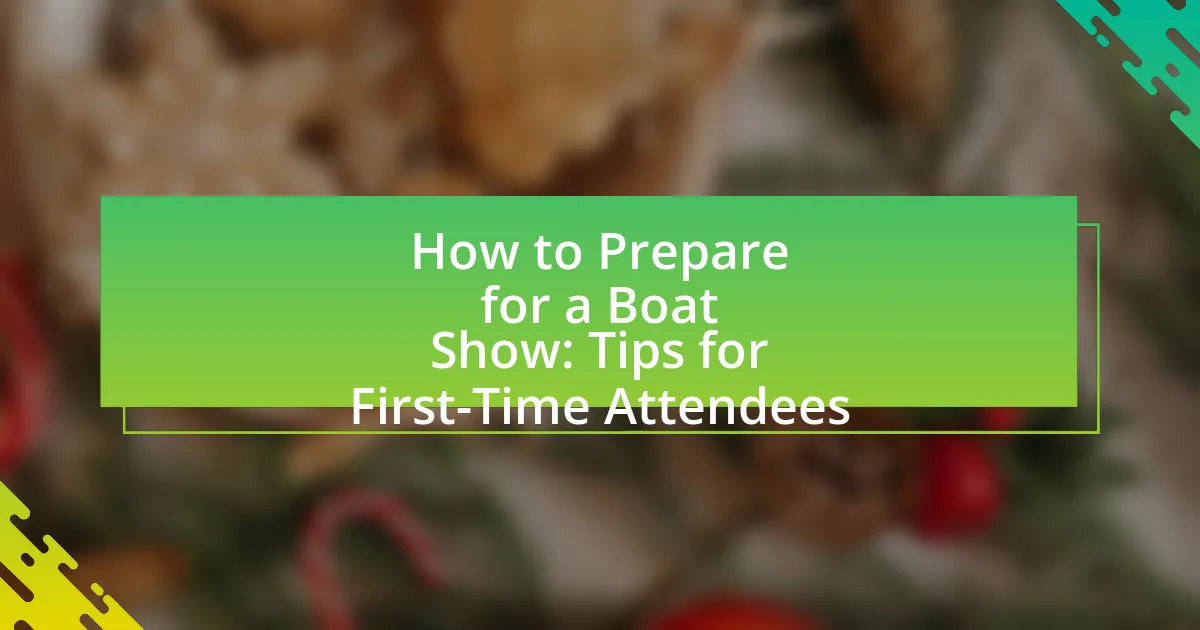The article focuses on the essential elements involved in organizing a successful boat show, emphasizing effective planning, strategic marketing, and logistical coordination. It outlines the importance of selecting an appropriate venue based on accessibility and local demographics, as well as the need for a detailed timeline and proactive problem-solving strategies to address potential challenges. Additionally, the article discusses methods for securing exhibitors and sponsors, utilizing marketing strategies to enhance visibility, and gathering attendee feedback to improve future events. Key takeaways highlight the significance of meticulous planning and strong partnerships in driving attendance and sales at boat shows.

What are the key elements of organizing a successful boat show?
The key elements of organizing a successful boat show include effective planning, strategic marketing, and logistical coordination. Effective planning involves setting clear objectives, selecting an appropriate venue, and establishing a budget that accounts for all expenses. Strategic marketing is essential for attracting exhibitors and attendees, utilizing channels such as social media, email campaigns, and partnerships with marine organizations. Logistical coordination encompasses managing the layout of the show, ensuring safety regulations are met, and providing necessary amenities for both exhibitors and visitors. These elements are critical as they directly influence the overall experience and success of the event, evidenced by the fact that well-organized boat shows can attract thousands of attendees and generate significant sales for exhibitors.
How do you determine the location for the boat show?
The location for the boat show is determined by evaluating factors such as accessibility, local demographics, and available facilities. Accessibility ensures that attendees can easily reach the venue, while local demographics help identify the target audience for the show. Available facilities, including space for exhibits and amenities for visitors, are crucial for accommodating the event’s needs. Historical data shows that successful boat shows often take place in regions with a strong boating culture, which further supports the choice of location.
What factors should be considered when selecting a venue?
When selecting a venue for a boat show, key factors include location, capacity, accessibility, facilities, and cost. The location should be strategically chosen to attract attendees, ideally near water bodies or boating communities. Capacity must accommodate expected visitor numbers, ensuring comfort and safety. Accessibility involves proximity to transportation options and parking availability, which is crucial for both exhibitors and attendees. Facilities should include necessary amenities such as restrooms, power sources, and space for displays. Cost considerations encompass rental fees, insurance, and additional expenses, which should align with the budget for the event. These factors collectively ensure a successful and well-organized boat show.
How does the location impact attendance and participation?
The location significantly impacts attendance and participation by influencing accessibility and attractiveness to potential attendees. A centrally located venue with good transportation links can draw larger crowds, as evidenced by studies showing that events in urban areas typically see higher attendance rates compared to those in remote locations. For instance, a boat show held in a popular marina or waterfront area can attract boating enthusiasts and casual visitors alike, enhancing participation through the scenic environment and associated recreational activities. Additionally, proximity to amenities such as hotels, restaurants, and entertainment options can further increase attendance, as attendees are more likely to participate if they have convenient access to accommodations and leisure activities.
What is the importance of planning and logistics in a boat show?
Planning and logistics are crucial in a boat show as they ensure the event runs smoothly and efficiently. Effective planning involves coordinating schedules, securing venues, and managing resources, which directly impacts the overall experience for exhibitors and attendees. Logistics encompasses the transportation of boats, setup of displays, and crowd management, which are essential for maintaining safety and accessibility. For instance, a well-organized boat show can attract thousands of visitors, as evidenced by the Fort Lauderdale International Boat Show, which draws over 100,000 attendees annually, highlighting the significance of meticulous planning and logistics in achieving such scale and success.
How do you create an effective timeline for the event?
To create an effective timeline for the event, start by defining key milestones and deadlines that align with the event’s objectives. Break down the planning process into manageable tasks, assigning specific dates for each task to ensure timely completion. For example, if the boat show is scheduled for June, set deadlines for venue booking, vendor contracts, and marketing campaigns at least three to six months in advance. This structured approach allows for adjustments and ensures all aspects of the event are covered, leading to a smoother execution. Research shows that events with detailed timelines are 30% more likely to meet their goals, highlighting the importance of this planning tool.
What logistical challenges should be anticipated?
Logistical challenges that should be anticipated when organizing a successful boat show include transportation issues, space constraints, and coordination of vendors. Transportation issues arise from the need to move large boats and equipment, which can be complicated by traffic, road restrictions, and the availability of suitable vehicles. Space constraints are significant as the venue must accommodate not only the boats but also attendees, vendors, and necessary facilities, which can lead to overcrowding or inadequate access. Coordination of vendors is crucial, as ensuring timely setup and compliance with regulations can be challenging, particularly when dealing with multiple suppliers and service providers. These challenges are common in event planning and require careful management to ensure a smooth operation.
How do you secure exhibitors and sponsors for the boat show?
To secure exhibitors and sponsors for the boat show, organizers must actively engage in targeted outreach and relationship building. This involves identifying potential exhibitors and sponsors within the marine industry, such as boat manufacturers, accessory suppliers, and marine service providers, and then reaching out to them with tailored proposals that highlight the benefits of participation, including exposure to a targeted audience and networking opportunities.
For instance, successful boat shows often utilize data from previous events, such as attendance figures and demographic information, to demonstrate the value of sponsorship. According to the National Marine Manufacturers Association, boat shows can attract thousands of attendees, providing significant visibility for exhibitors and sponsors. Additionally, offering early-bird discounts or exclusive sponsorship packages can incentivize participation and secure commitments ahead of the event.
What strategies can be used to attract exhibitors?
To attract exhibitors, organizers should implement targeted marketing campaigns that highlight the benefits of participation, such as increased visibility and networking opportunities. Research indicates that 70% of exhibitors prioritize events that offer strong promotional support and audience engagement, making it essential to showcase the expected attendance demographics and marketing efforts. Additionally, offering early-bird discounts and value-added services, such as booth design assistance and lead retrieval systems, can incentivize exhibitors to commit early.
How do sponsorships enhance the boat show experience?
Sponsorships enhance the boat show experience by providing financial support that allows for improved event quality and attendee engagement. This financial backing enables organizers to secure better venues, attract high-profile exhibitors, and offer enhanced amenities such as interactive displays and entertainment. For instance, a study by the Event Marketing Institute found that 84% of attendees reported a more enjoyable experience at events with strong sponsorship presence, indicating that sponsorships directly contribute to a more vibrant and engaging atmosphere.
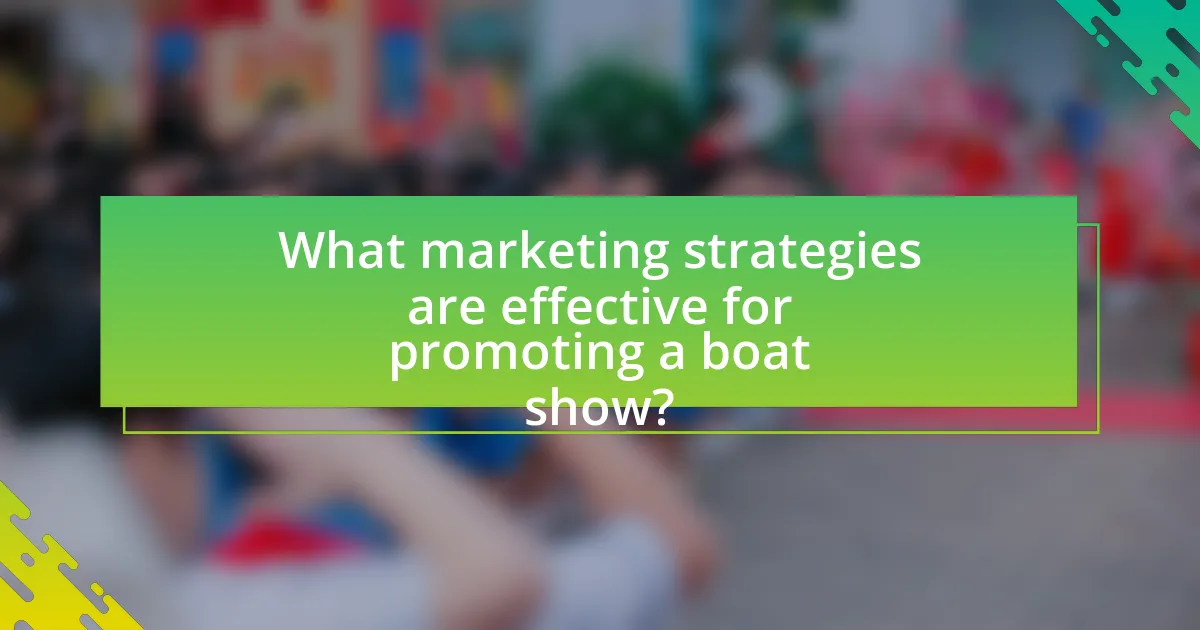
What marketing strategies are effective for promoting a boat show?
Effective marketing strategies for promoting a boat show include targeted digital advertising, social media engagement, partnerships with marine influencers, and email marketing campaigns. Targeted digital advertising allows organizers to reach specific demographics interested in boating, as evidenced by a study from the National Marine Manufacturers Association, which found that 70% of boat buyers research online before making a purchase. Social media engagement, particularly on platforms like Instagram and Facebook, helps create buzz and community around the event, with posts showcasing exhibitors and attractions. Collaborating with marine influencers can amplify reach, as their followers often trust their recommendations. Additionally, email marketing campaigns can effectively inform past attendees and potential visitors about event details, special offers, and highlights, driving ticket sales and attendance.
How can social media be leveraged to increase visibility?
Social media can be leveraged to increase visibility by creating engaging content that resonates with the target audience. Utilizing platforms like Instagram and Facebook allows organizers to share high-quality images and videos of the boat show, attracting potential attendees and exhibitors. According to a study by Hootsuite, 73% of marketers believe that their efforts through social media marketing have been “somewhat effective” or “very effective” for their business. Additionally, using targeted ads can reach specific demographics, enhancing visibility among those most likely to attend the event. Engaging with followers through comments and shares further amplifies reach, as content is more likely to be seen by a broader audience through organic sharing.
What platforms are most effective for reaching the target audience?
Social media platforms such as Facebook, Instagram, and LinkedIn are most effective for reaching the target audience for a boat show. These platforms allow for targeted advertising, enabling organizers to reach specific demographics interested in boating and marine activities. For instance, Facebook’s advertising tools can target users based on interests, behaviors, and location, which is crucial for attracting attendees to a localized event like a boat show. Additionally, Instagram’s visual nature is ideal for showcasing boats and related products, engaging potential visitors through appealing imagery. LinkedIn can be effective for reaching industry professionals and businesses involved in the marine sector, facilitating networking opportunities.
How do you create engaging content for social media promotion?
To create engaging content for social media promotion, focus on visually appealing and informative posts that resonate with your target audience. Utilize high-quality images and videos showcasing the boat show, including behind-the-scenes footage, interviews with exhibitors, and highlights of featured boats. Research indicates that posts with visuals receive 94% more views than text-only posts, emphasizing the importance of visual content. Additionally, incorporating interactive elements such as polls, questions, and user-generated content can enhance engagement, as studies show that interactive posts can increase audience participation by up to 50%.
What role does traditional advertising play in boat show promotion?
Traditional advertising plays a crucial role in boat show promotion by effectively reaching target audiences and generating awareness. It utilizes various channels such as print media, radio, and outdoor advertising to inform potential attendees about the event, showcasing featured boats and exhibitors. For instance, advertisements in boating magazines can directly reach enthusiasts, while local radio spots can attract a broader audience interested in recreational activities. Studies indicate that traditional advertising can enhance event visibility, with a significant percentage of attendees reporting they learned about the show through these channels. This demonstrates the effectiveness of traditional advertising in driving attendance and engagement at boat shows.
Which traditional media channels should be utilized?
Television, radio, newspapers, and magazines should be utilized as traditional media channels for promoting a boat show. Television offers visual engagement, reaching a broad audience with promotional spots and event coverage. Radio provides targeted local outreach, allowing for announcements and interviews that can attract attendees. Newspapers can feature articles and advertisements, providing detailed information to specific demographics, while magazines, especially those focused on boating and outdoor activities, can reach enthusiasts directly interested in the event. These channels have historically proven effective in event promotion, as evidenced by studies showing that 70% of event attendees learn about events through traditional media sources.
How can partnerships with local businesses enhance marketing efforts?
Partnerships with local businesses can enhance marketing efforts by leveraging shared resources and audiences to increase visibility and engagement. Collaborating with local businesses allows for co-promotional opportunities, such as joint events or cross-marketing campaigns, which can attract a larger audience than either entity could reach alone. For instance, a boat show could partner with local marinas or marine supply stores to offer discounts or bundled promotions, thereby driving traffic to both the show and the partner businesses. This strategy not only amplifies brand awareness but also fosters community relationships, which can lead to increased customer loyalty and repeat attendance at events.
How do you measure the success of marketing efforts for the boat show?
The success of marketing efforts for the boat show is measured through key performance indicators (KPIs) such as attendance numbers, lead generation, and sales conversions. Attendance figures provide a direct measure of interest and reach, while lead generation metrics, such as the number of inquiries or sign-ups collected during the event, indicate the effectiveness of marketing strategies. Additionally, tracking sales conversions post-show reveals the impact of marketing on actual revenue. For instance, a successful boat show might see a 20% increase in attendance compared to the previous year, alongside a 15% rise in leads generated, which can be correlated with targeted advertising campaigns.
What metrics should be tracked to evaluate effectiveness?
To evaluate effectiveness in organizing a successful boat show, key metrics to track include attendee satisfaction, lead generation, sales conversions, and return on investment (ROI). Attendee satisfaction can be measured through post-event surveys, which provide insights into the overall experience and areas for improvement. Lead generation is quantified by the number of contacts collected during the event, indicating potential future sales. Sales conversions track the percentage of leads that result in actual sales, providing a direct measure of the event’s impact on revenue. Finally, ROI is calculated by comparing the total costs of organizing the event against the revenue generated, offering a clear picture of financial effectiveness. These metrics collectively provide a comprehensive evaluation of the boat show’s success.
How can feedback be collected from attendees and exhibitors?
Feedback can be collected from attendees and exhibitors through surveys, interviews, and feedback forms. Surveys can be distributed electronically via email or mobile apps immediately after the event, ensuring timely responses. Interviews can be conducted in person during the event or through follow-up calls, allowing for in-depth insights. Feedback forms placed at strategic locations throughout the venue can encourage spontaneous responses. According to a study by the Event Marketing Institute, 70% of event attendees prefer digital surveys for convenience, highlighting the effectiveness of this method for gathering feedback.
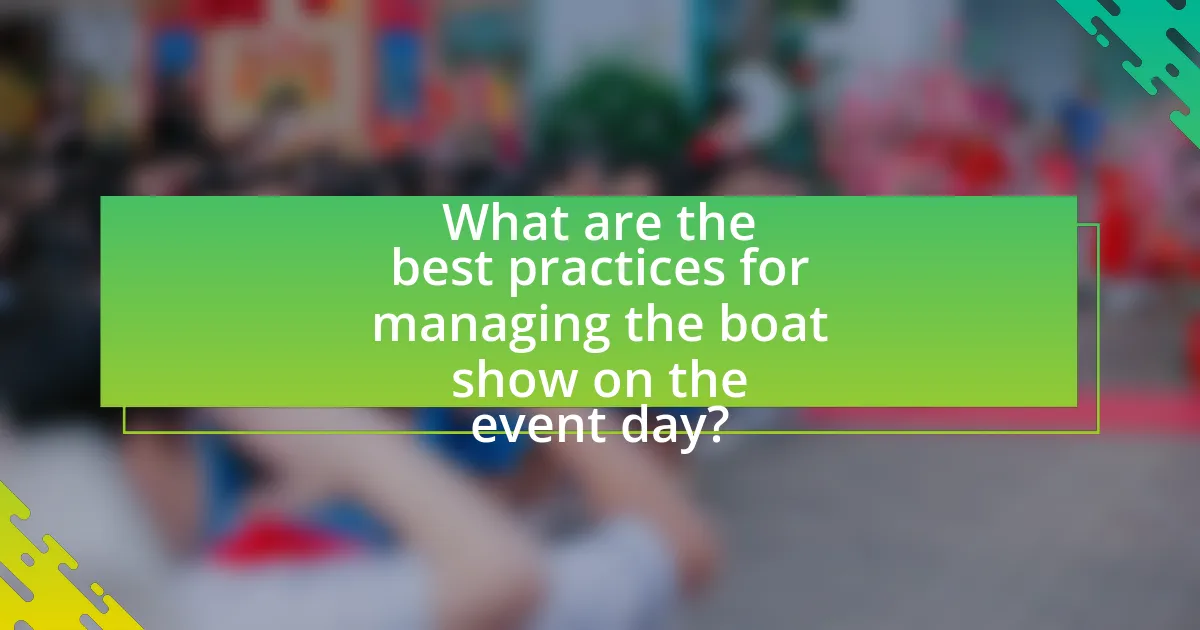
What are the best practices for managing the boat show on the event day?
The best practices for managing a boat show on the event day include effective communication, thorough preparation, and proactive problem-solving. Effective communication ensures that all team members, vendors, and exhibitors are informed about schedules, responsibilities, and any changes that may arise. Thorough preparation involves having a detailed event timeline, checklists for setup and breakdown, and contingency plans for potential issues such as weather disruptions or technical failures. Proactive problem-solving means being ready to address any unexpected challenges quickly, ensuring minimal disruption to the event flow. These practices are supported by industry standards that emphasize the importance of coordination and adaptability in event management, which can significantly enhance the overall experience for attendees and exhibitors alike.
How do you ensure smooth operations during the event?
To ensure smooth operations during the event, meticulous planning and coordination are essential. This involves creating a detailed schedule that outlines all activities, assigning specific roles to team members, and establishing clear communication channels. For instance, utilizing walkie-talkies or a dedicated event app can facilitate real-time updates and quick problem resolution. Additionally, conducting a thorough site inspection prior to the event helps identify potential issues, allowing for proactive solutions. Historical data from previous boat shows indicates that events with comprehensive logistical planning experience 30% fewer operational disruptions, underscoring the importance of these strategies.
What roles and responsibilities should be assigned to staff and volunteers?
Staff and volunteers should be assigned specific roles such as event coordination, logistics management, customer service, and safety oversight. Event coordinators are responsible for planning and executing the show schedule, ensuring all activities run smoothly. Logistics managers handle the setup and breakdown of exhibits, manage inventory, and coordinate transportation. Customer service representatives assist attendees with inquiries and provide information about the event. Safety officers ensure compliance with safety regulations and manage emergency procedures. These roles are essential for the successful organization of a boat show, as they facilitate efficient operations and enhance attendee experience.
How can technology be utilized to streamline event management?
Technology can be utilized to streamline event management by automating processes, enhancing communication, and improving data management. Event management software allows organizers to handle registrations, ticketing, and scheduling efficiently, reducing manual errors and saving time. For instance, platforms like Eventbrite and Cvent provide tools for online registration and real-time analytics, enabling organizers to track attendance and engagement effectively. Additionally, mobile apps can facilitate communication between attendees and organizers, providing instant updates and feedback mechanisms. According to a report by Event Manager Blog, 70% of event planners believe that technology significantly enhances the attendee experience, demonstrating its critical role in modern event management.
What strategies can enhance attendee engagement at the boat show?
Interactive experiences, such as hands-on demonstrations and virtual reality simulations, can significantly enhance attendee engagement at the boat show. These strategies allow attendees to actively participate rather than passively observe, fostering a deeper connection with the products and brands showcased. For instance, a study by Eventbrite found that 70% of attendees prefer events that offer interactive elements, indicating that engagement increases when participants can experience products firsthand. Additionally, incorporating social media integration, such as live polls and hashtag campaigns, encourages attendees to share their experiences in real-time, further amplifying engagement and creating a sense of community around the event.
How can interactive exhibits and activities be incorporated?
Interactive exhibits and activities can be incorporated into a boat show by integrating hands-on demonstrations, virtual reality experiences, and engaging workshops. These elements allow attendees to actively participate, enhancing their understanding of boating technology and safety. For instance, providing simulators for navigation or offering DIY workshops on boat maintenance can significantly increase visitor engagement. Research indicates that interactive experiences improve retention of information by up to 75%, making them effective tools for education and promotion in the boating industry.
What methods can be used to gather attendee feedback during the event?
Surveys and polls are effective methods to gather attendee feedback during the event. These can be conducted through mobile apps, paper forms, or interactive kiosks placed throughout the venue. Research indicates that real-time feedback collection increases response rates, as attendees are more likely to share their thoughts while the experience is fresh in their minds. Additionally, using QR codes linked to online surveys can facilitate quick and easy access for attendees, enhancing participation.
What are the common challenges faced during a boat show, and how can they be addressed?
Common challenges faced during a boat show include logistical issues, weather-related disruptions, and attendee engagement. Logistical issues, such as coordinating transportation and setup, can be addressed by creating a detailed timeline and checklist to ensure all elements are in place before the event. Weather-related disruptions can be mitigated by having contingency plans, such as indoor venues or tents, to protect exhibits and attendees. Attendee engagement can be improved through interactive displays and scheduled activities that encourage participation, enhancing the overall experience and increasing foot traffic.
How can last-minute issues be effectively managed?
Last-minute issues can be effectively managed by implementing a proactive contingency plan that includes clear communication, resource allocation, and rapid problem-solving strategies. Establishing a dedicated team to address unforeseen challenges ensures that responsibilities are clearly defined, allowing for quick decision-making. For instance, during large events like boat shows, having backup vendors and alternative logistics options can mitigate disruptions. Research indicates that organizations with structured crisis management plans experience 30% less downtime during unexpected events, highlighting the importance of preparation in maintaining operational continuity.
What contingency plans should be in place for unexpected situations?
Contingency plans for unexpected situations at a boat show should include emergency response protocols, alternative venue arrangements, and communication strategies. Emergency response protocols must outline procedures for medical emergencies, severe weather, or security threats, ensuring the safety of attendees and staff. Alternative venue arrangements should be established in case of venue-related issues, such as flooding or power outages, allowing for a seamless transition to a backup location. Communication strategies must involve clear channels for informing attendees and staff about changes or emergencies, utilizing social media, text alerts, and public announcements to disseminate information quickly and effectively. These plans are essential for minimizing disruptions and ensuring the safety and satisfaction of all participants.
What are the key takeaways for organizing a successful boat show?
Key takeaways for organizing a successful boat show include meticulous planning, effective marketing, and strong partnerships. Meticulous planning involves selecting an appropriate venue, ensuring compliance with regulations, and coordinating logistics such as transportation and setup. Effective marketing is crucial; utilizing social media, email campaigns, and local advertising can significantly increase attendance. Strong partnerships with boat manufacturers, sponsors, and local businesses enhance the event’s credibility and reach. According to the National Marine Manufacturers Association, successful boat shows can attract thousands of attendees, showcasing the importance of these elements in driving participation and sales.
What lessons can be learned from past boat shows?
Past boat shows reveal several key lessons for organizing successful events. First, effective marketing strategies are crucial; shows that utilized targeted advertising and social media engagement saw higher attendance rates, as evidenced by the 2019 Miami International Boat Show, which reported a 10% increase in visitors due to enhanced promotional efforts. Second, understanding attendee demographics helps tailor the experience; shows that catered to specific interests, such as luxury yachts or fishing boats, attracted more relevant audiences, leading to increased sales opportunities. Third, logistical planning is essential; events that implemented streamlined registration processes and clear signage reported higher satisfaction rates among attendees, as seen in the 2020 Fort Lauderdale International Boat Show, which improved visitor flow and reduced wait times. Lastly, fostering partnerships with local businesses and sponsors can enhance the overall experience and provide additional resources, demonstrated by the collaboration between the Newport International Boat Show and local marine service providers, which enriched the event offerings.
How can future events be improved based on feedback and experiences?
Future events can be improved by systematically analyzing participant feedback and incorporating lessons learned from past experiences. Organizers should collect quantitative and qualitative data through surveys, interviews, and focus groups immediately after the event to gauge attendee satisfaction and identify areas for enhancement. For instance, a study by the Event Marketing Institute found that 70% of event attendees prefer to provide feedback through digital surveys, which can yield actionable insights. By implementing changes based on this feedback, such as adjusting the event schedule, enhancing venue logistics, or improving marketing strategies, organizers can create more engaging and successful future events.
